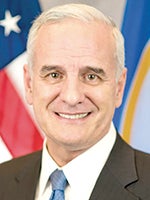A healthy starter? In Legislature, MNsure premium fix offers early shot at bipartisan success
Published 10:30 am Monday, January 9, 2017
By Erin Golden
Minneapolis Star Tribune
Thousands of Minnesotans dreading spiking health insurance premiums would see financial relief from the state in the coming months — if Gov. Mark Dayton and Republican lawmakers can clinch a deal still threatened by partisan differences.

Dayton
The DFL governor and GOP legislative leaders agree they want to respond quickly to Minnesotans faced with surging premiums in the state’s individual insurance market, which serves the self-employed and people not covered by an employer. Both sides have proposed pulling money from the state’s current budget surplus — Dayton wants $313 million, Republicans proposed $300 million.
Dayton opened the legislative session last week by demanding immediate action. Republican House Speaker Kurt Daudt vowed the full House would pass a bill by this Friday. But the same divisions that blocked premium relief at the end of 2016 are threatening to resurface.
Republicans want provisions aimed at helping insurance customers who could be forced to change doctors, or lose coverage for serious medical conditions. And the two sides have different ideas for distributing the rebates, and how long they should be in place. House members wrapped up their first week in the Capitol by squabbling in a floor debate about differences between the Dayton and GOP plans.
“There’s always tension at the beginning, and you break through it,” said Sen. Michelle Benson, R-Ham Lake, leading the health care effort in the Senate.
Both plans are aimed first at the approximately 123,000 people in Minnesota who buy their insurance from the individual market, but make too much money to qualify for federal subsidies. (The group includes individuals who make more than $47,520 or a family of four that makes more than $97,200.) People in that category have seen their monthly premiums spike by more than 50 percent.
Dayton’s plan, which he first proposed in October, would provide a 25 percent rebate to everyone in that group, for all of 2017. The approximately $313 million in subsidies would be funneled through insurance companies, which in turn would reduce bills to individual insurance buyers.
Dayton and DFL legislators championed the plan as a streamlined way to help people struggling to cover premium spikes. The goal, Dayton said, was to pass “a simple bill, straightforward premium relief because that’s what we need to do now, especially before January 31st, before people make their decisions about what kind of insurance policies they can afford for this year.”
The Republicans’ $300 million plan comes with more restrictions on eligibility. For the first three months, the plan would mirror the governor’s: a 25 percent premium reduction for anyone in the individual market who can’t get other subsidies. For the rest of 2017, reductions would only be available at specific income levels.
That category would include individuals who make less than $95,040 per year, or families of four making less than $194,400. The discounts would vary from 20 to 30 percent, depending on income.
Instead of going through insurance companies, Republicans would keep the process within state government. The Minnesota Management and Budget Office (MMB) would determine who qualifies for the discounts, and distribute them.
DFLers question if that office is best-situated for the new responsibility. Sorting out eligibility, and then getting checks out would require MMB to gather information it doesn’t currently maintain, and set up new systems — meaning more money and manpower.
Republicans also want to include several additional provisions that Dayton and DFLers aren’t on board with.
Among them: $15 million for people dealing with life-threatening conditions and other serious health issues who are in danger of losing coverage; allowing small businesses to make direct contributions toward health care premiums; and, more potentially controversial, authorizing for-profit health maintenance organizations, or HMOs, to operate in Minnesota. Currently, only nonprofit HMOs are allowed.
Benson and Rep. Joe Hoppe, R-Chaska, the sponsor of the bill in the House, said it was meant to help people outside the metro area who now have to seek care at clinics far from home.
“We’re trying to send a signal to the larger market that Minnesota is going to be different, and we want more offerings for the state,” Benson said. But Republicans said they had not yet discussed that provision with Dayton.
Daudt and Senate Majority Leader Paul Gazelka, R-Nisswa, said they have met with Dayton on premium relief in recent days. Benson said Gazelka’s “calm, engaged approach” is helping to make headway in those discussions.
If it pans out, both sides could claim a bipartisan victory that would start this year’s legislative session on a note of cooperation. It would be in sharp contrast to the final weeks of 2016, when Dayton and Daudt publicly sparred in letters and news conferences, pointing to each other as the reason there would be no special session on health care.
Staff writer Ricardo Lopez contributed to this report.


